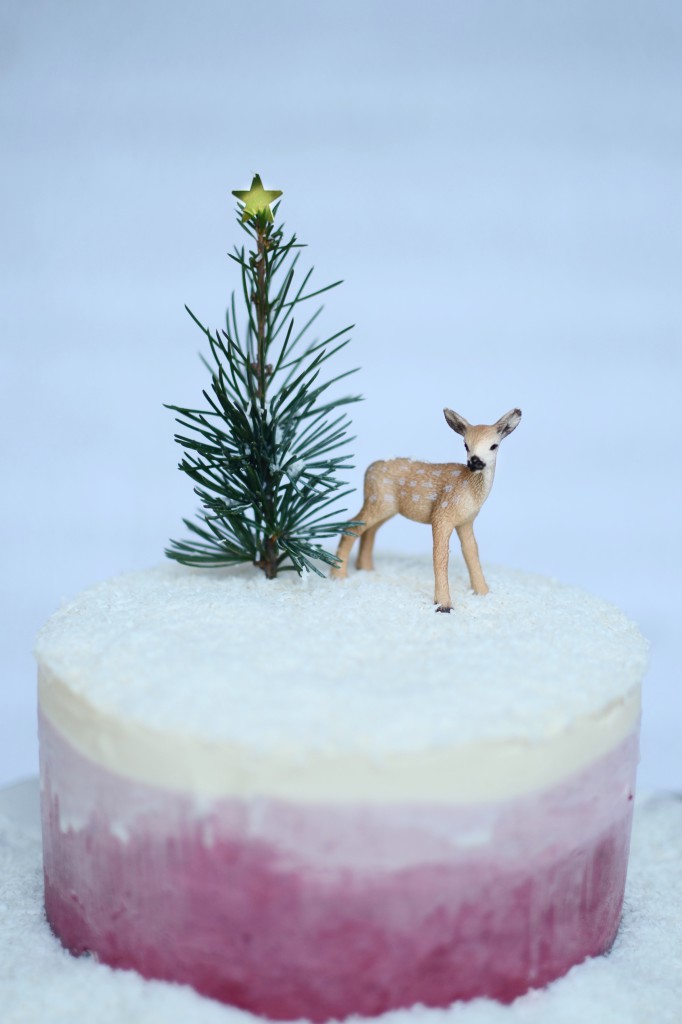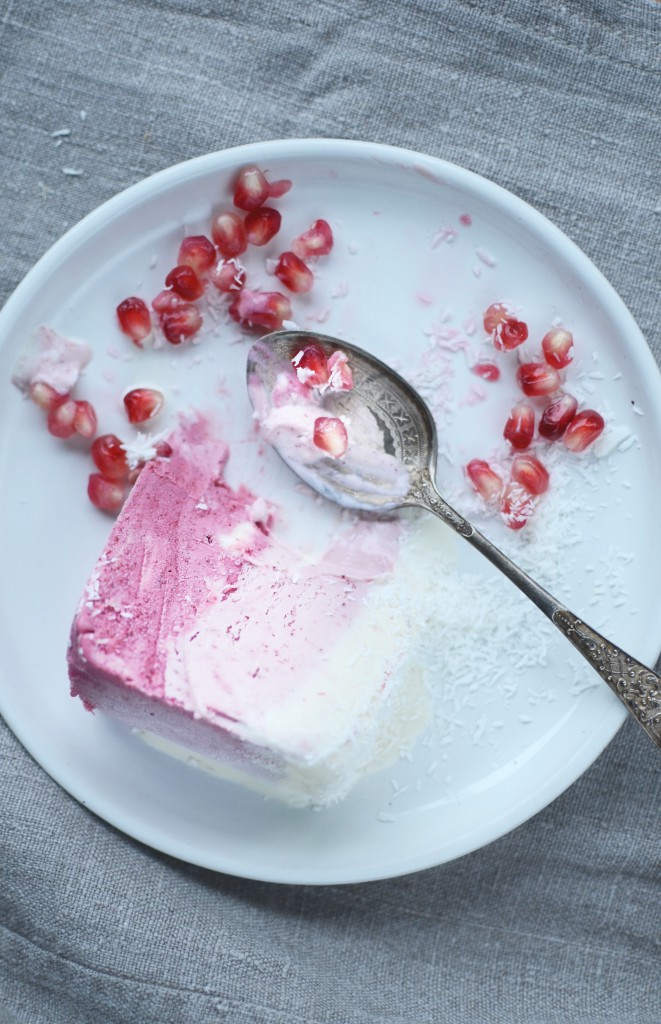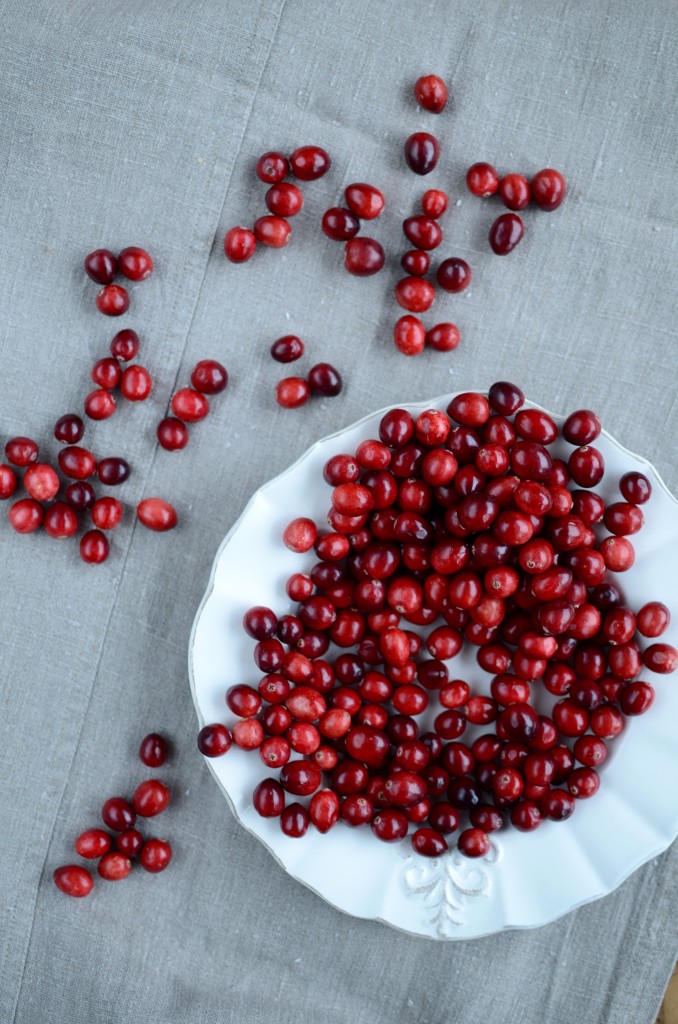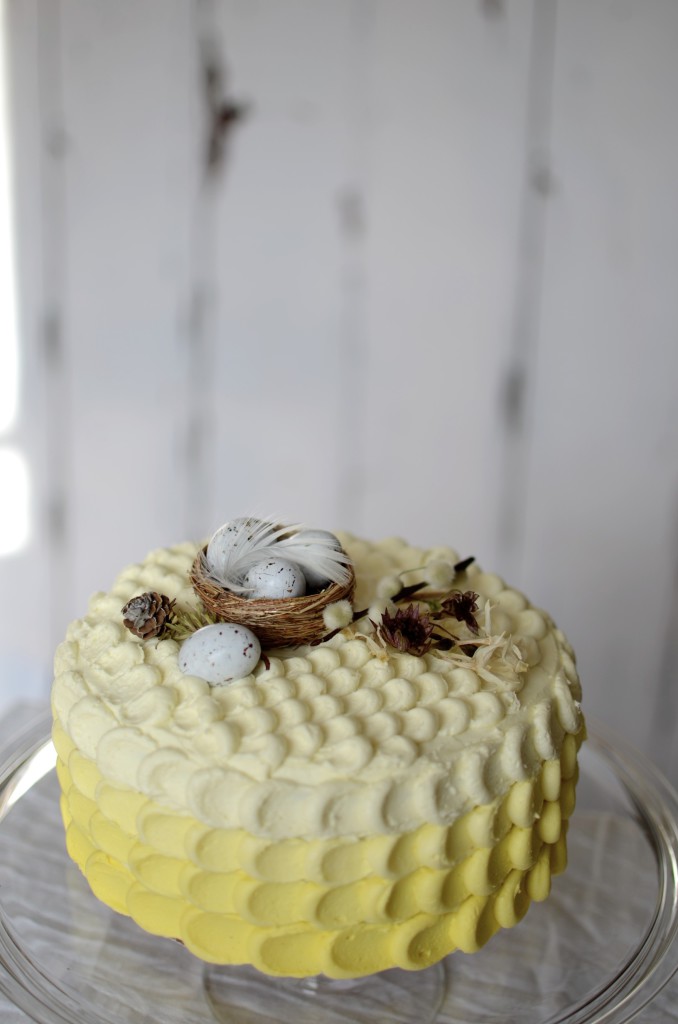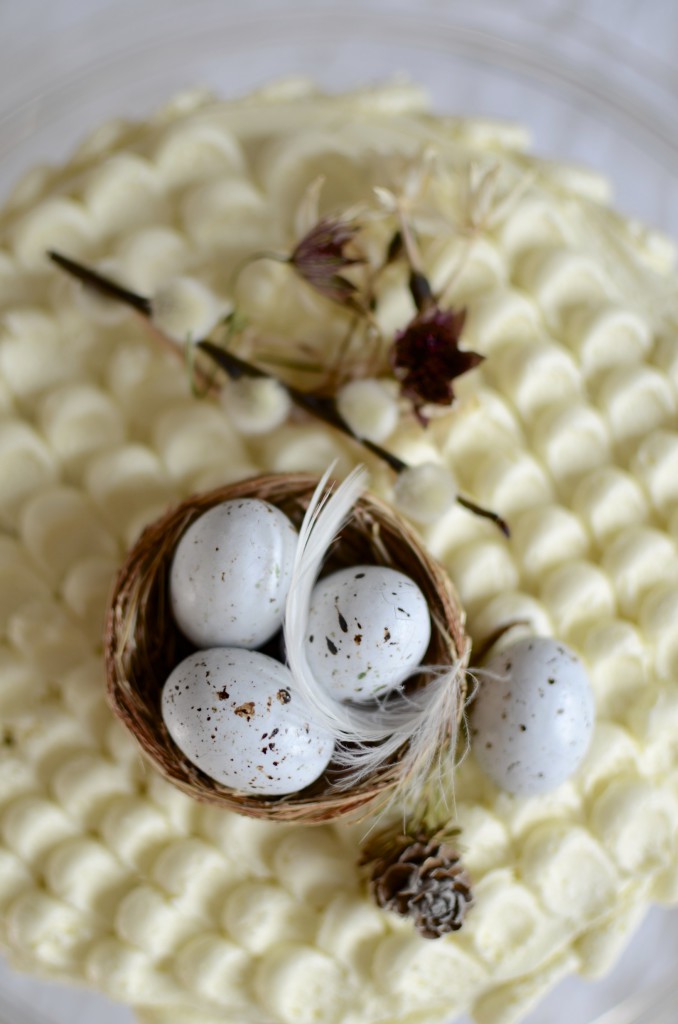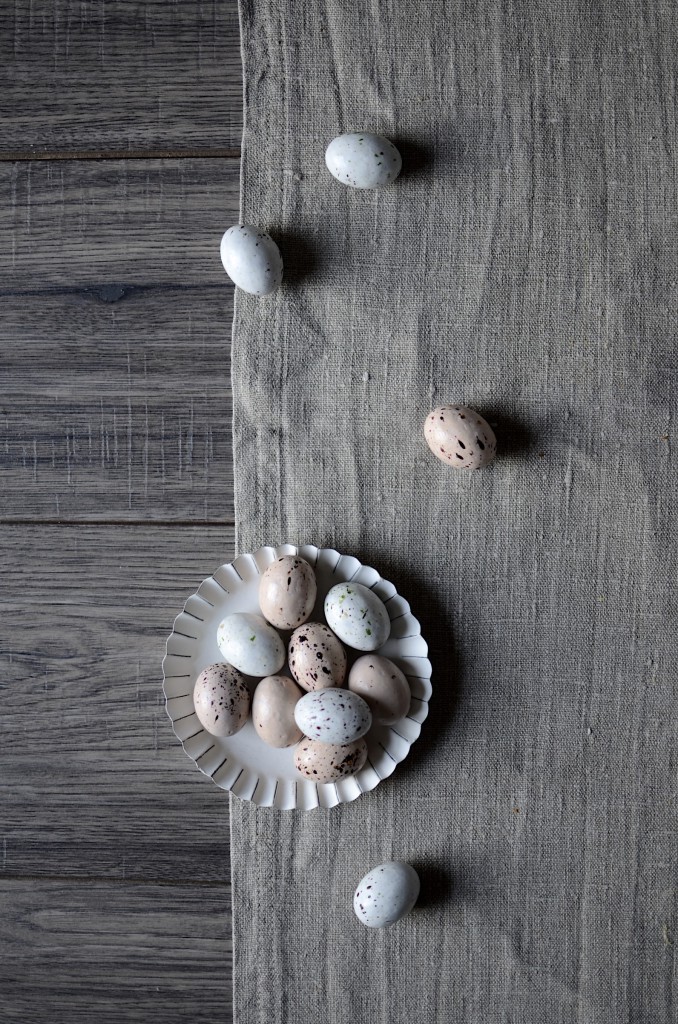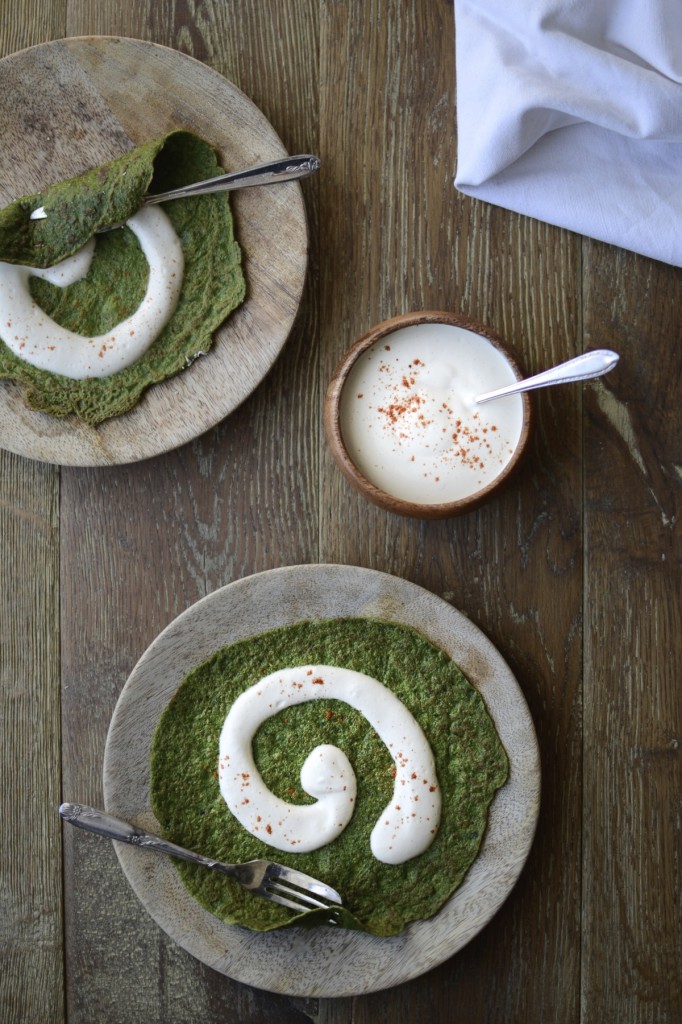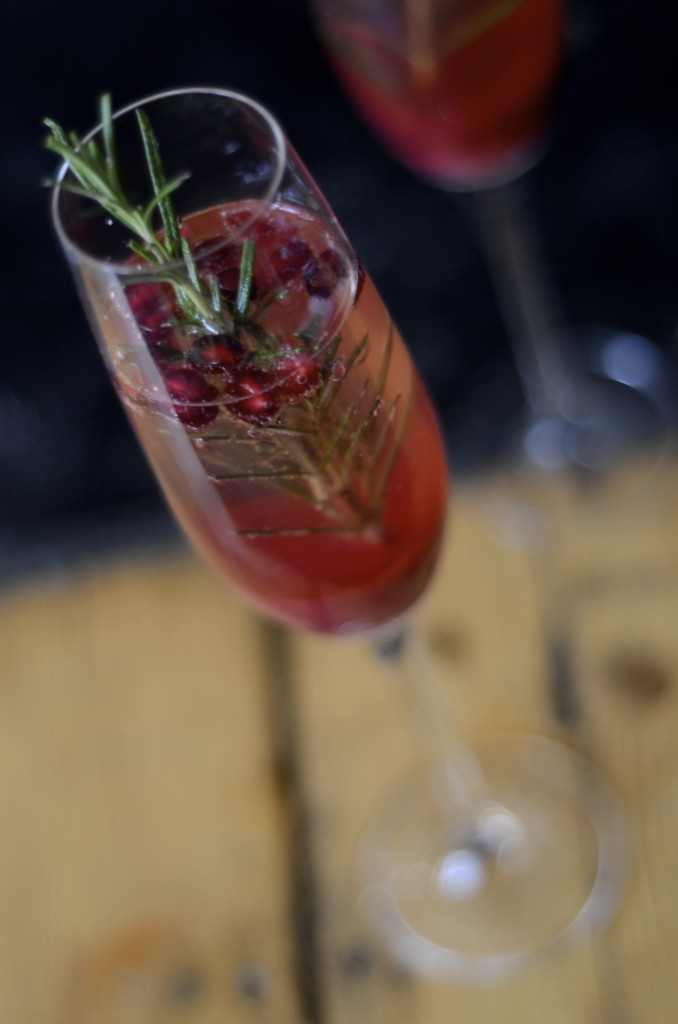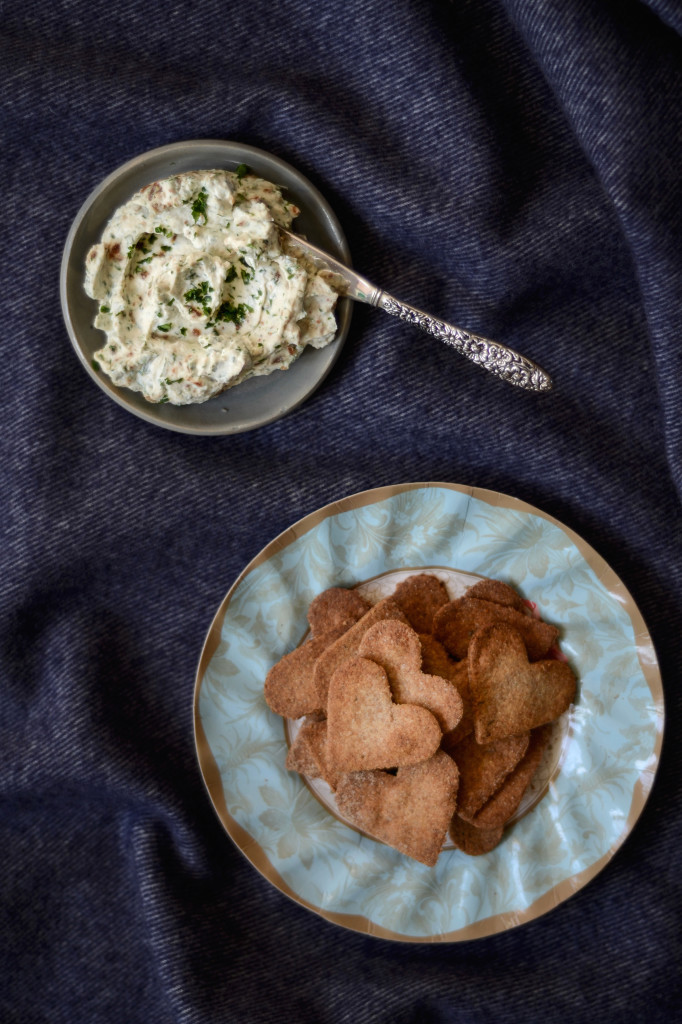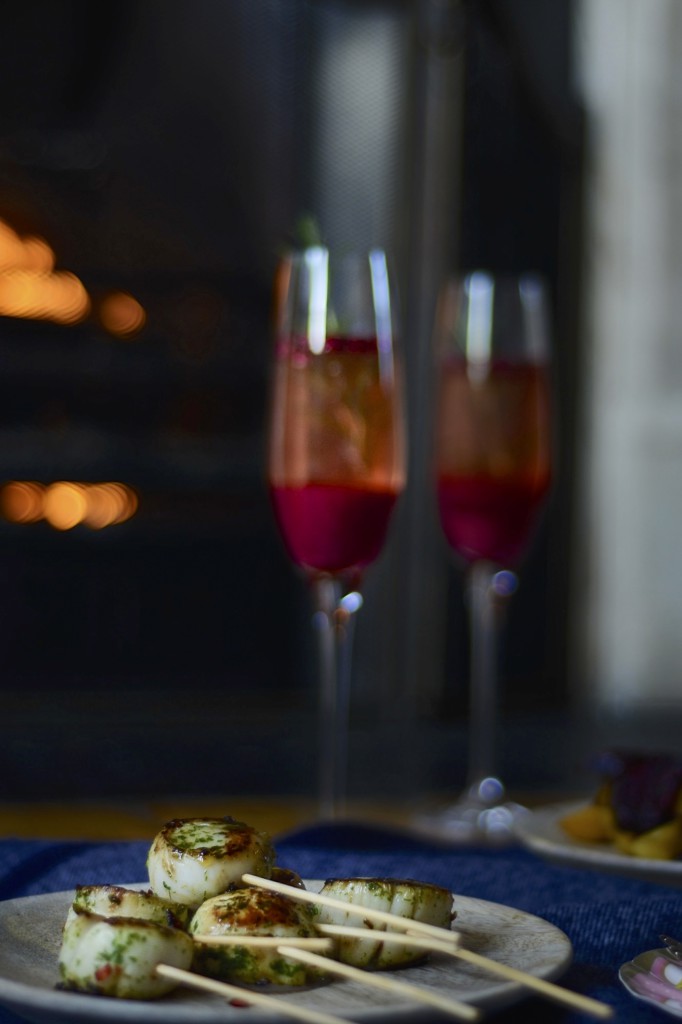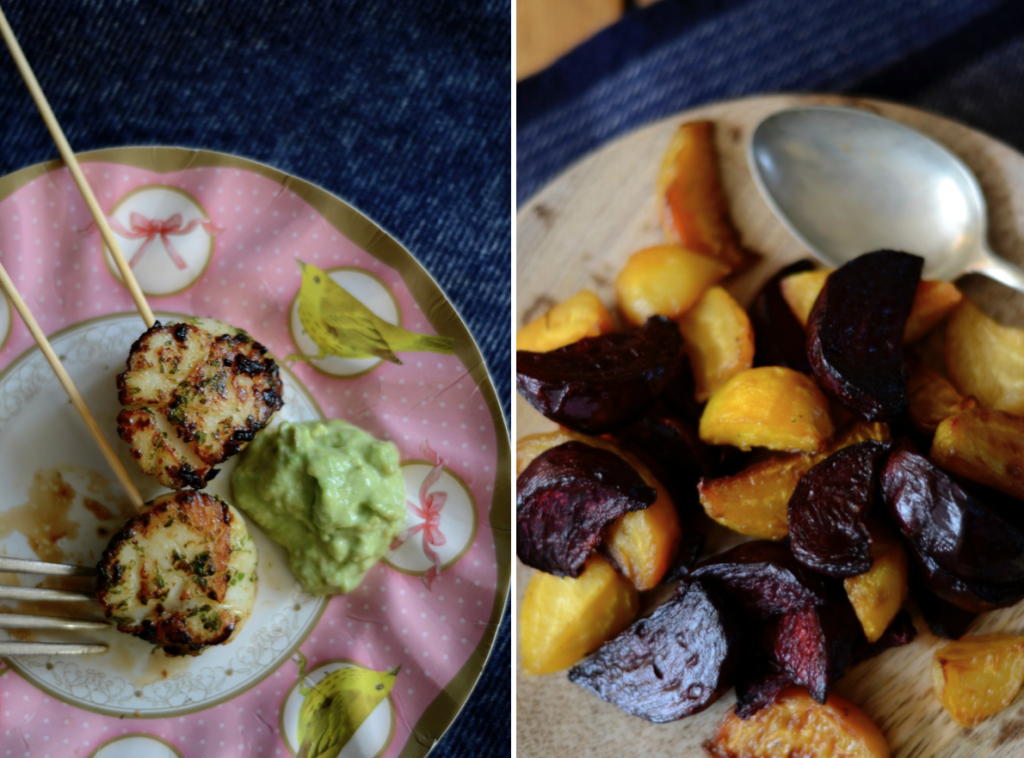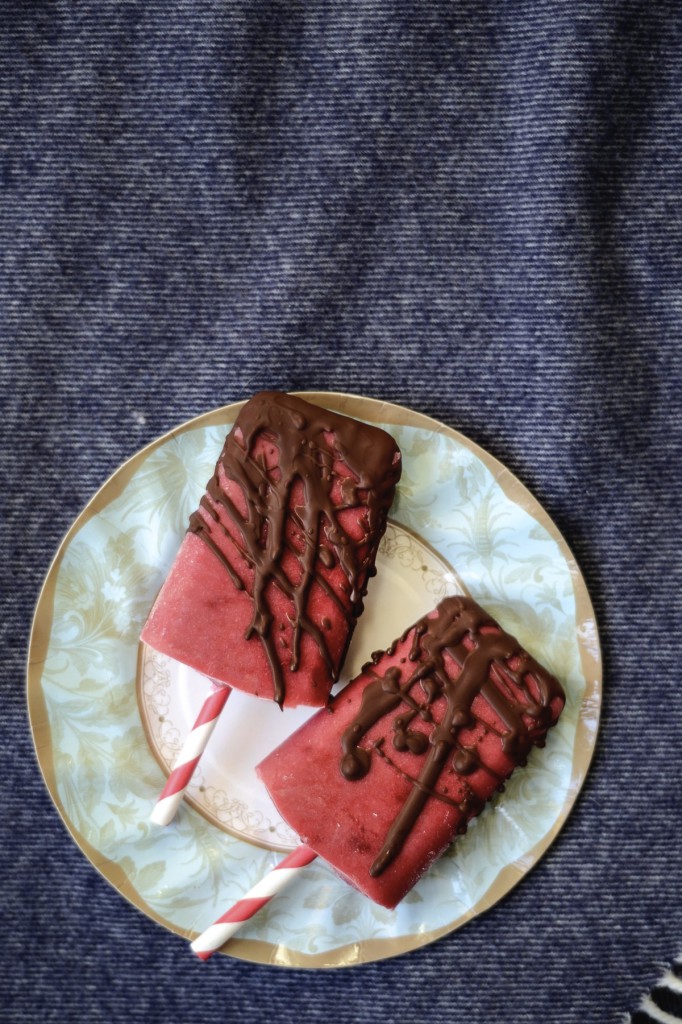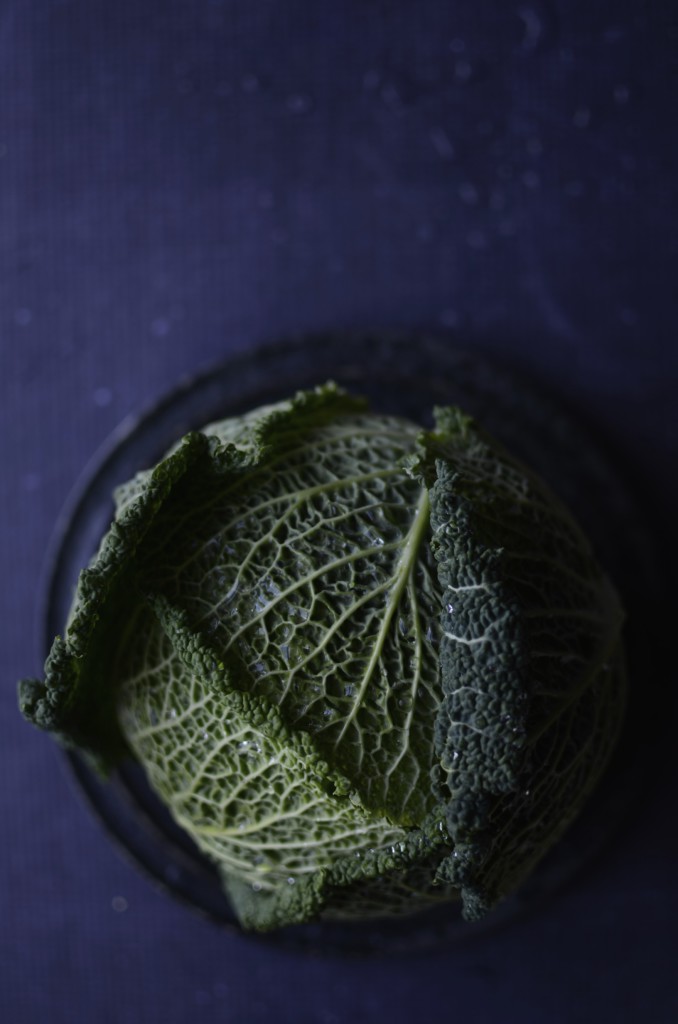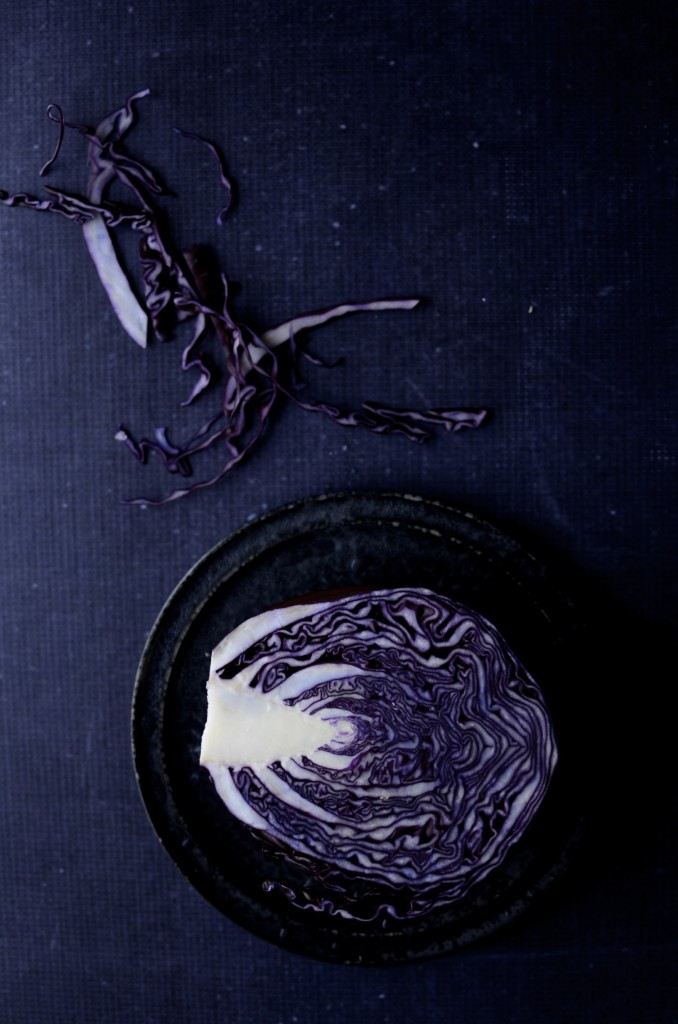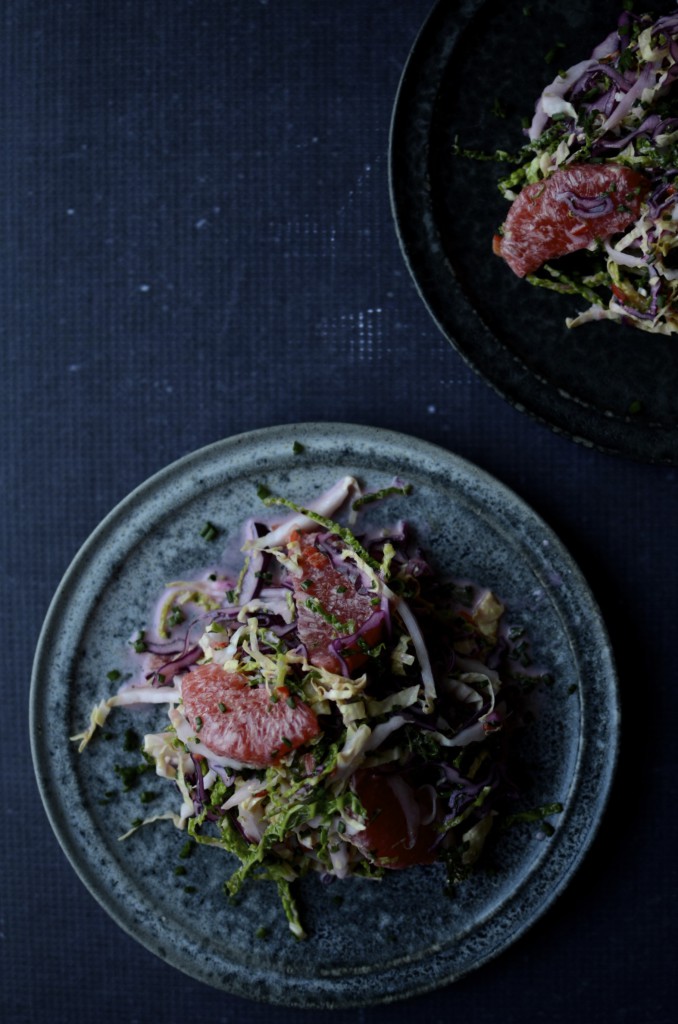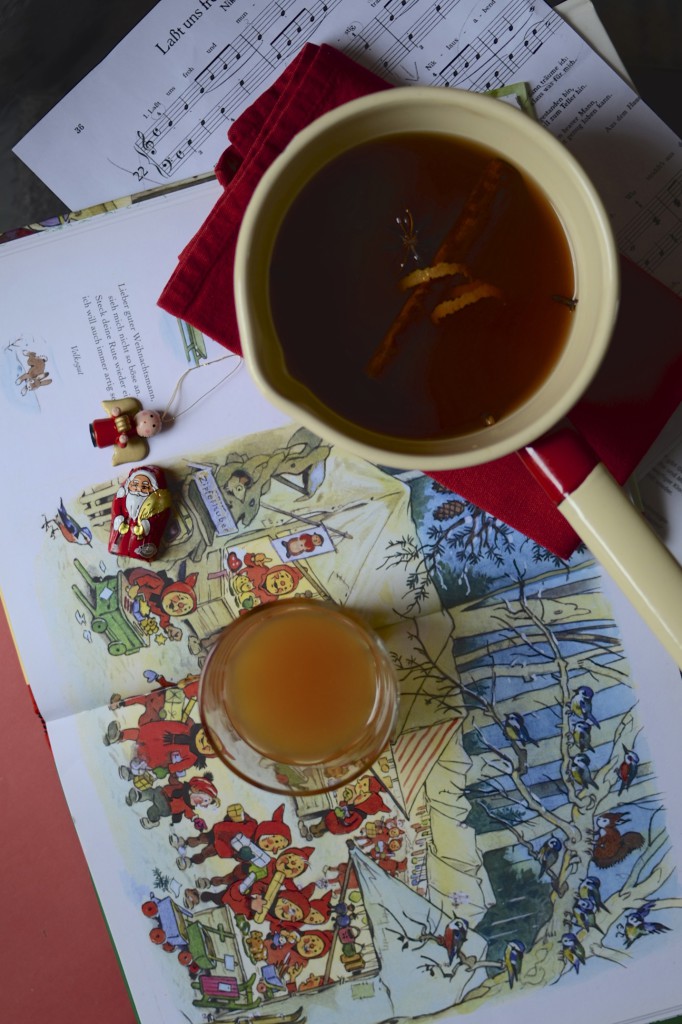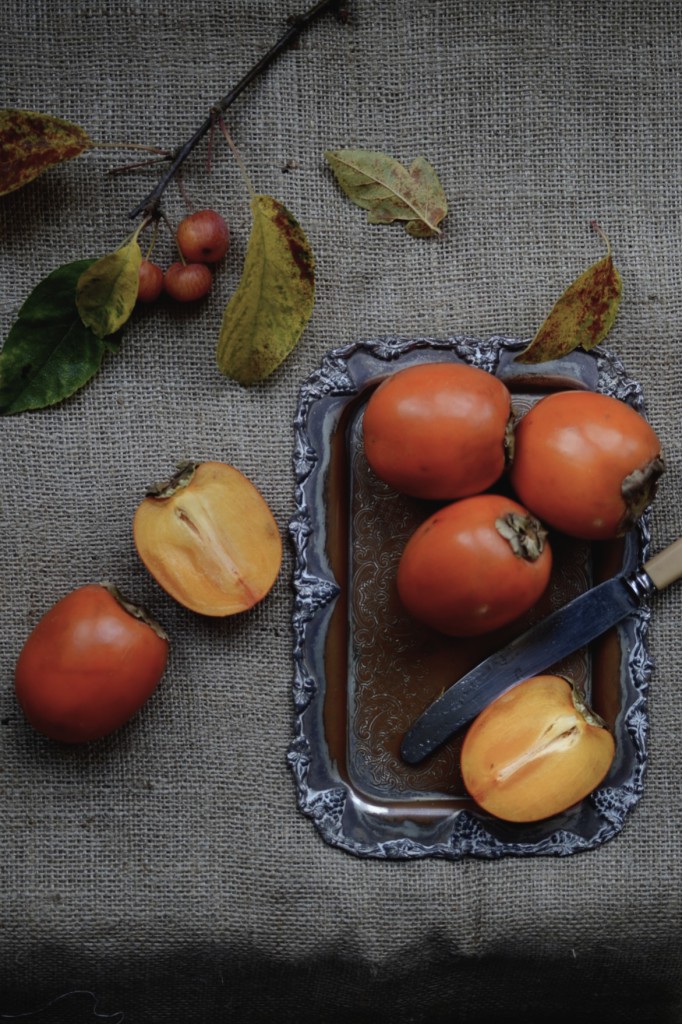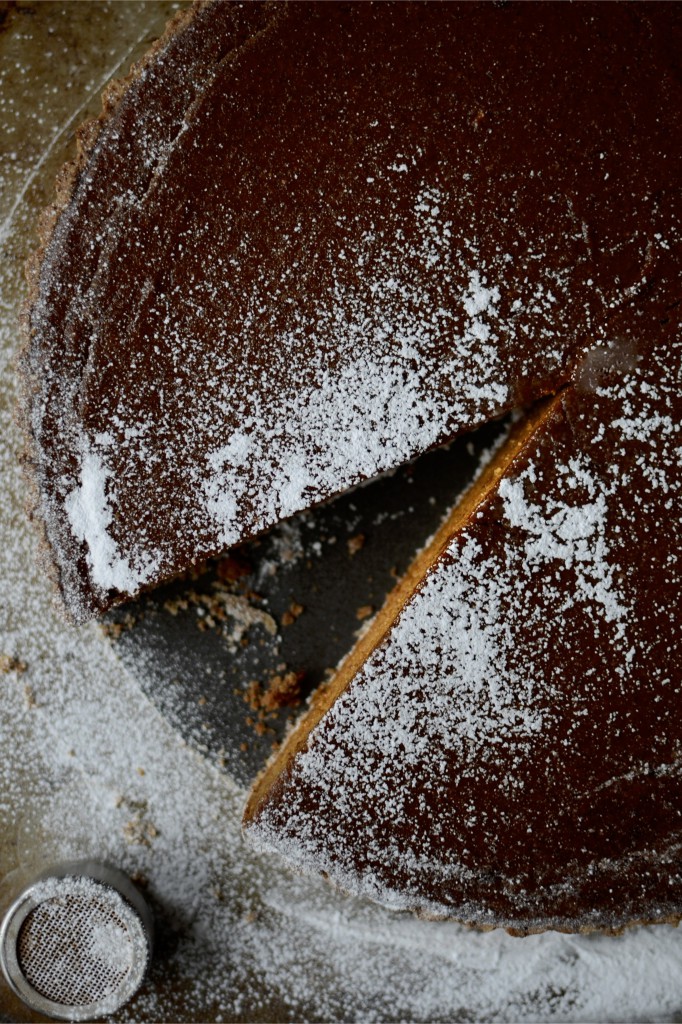Swede and sweet potato mash
The tree in our front garden is by now completely bare (although the neighbour’s tree is still haemorrhaging leaves) and my American friends are all preparing for their Thanksgiving feasts. I have yet to be invited to one, but am a huge fan of the traditional menu of sides that is usually served at these gatherings: cranberries in some shape or form, spiced pumpkin, sweet potatoes, sprouts, mashed potatoes and squashes. When I made this swede and sweet potato mash to go alongside our chilli last week, we all agreed that it would make an excellent addition to any festive meal.
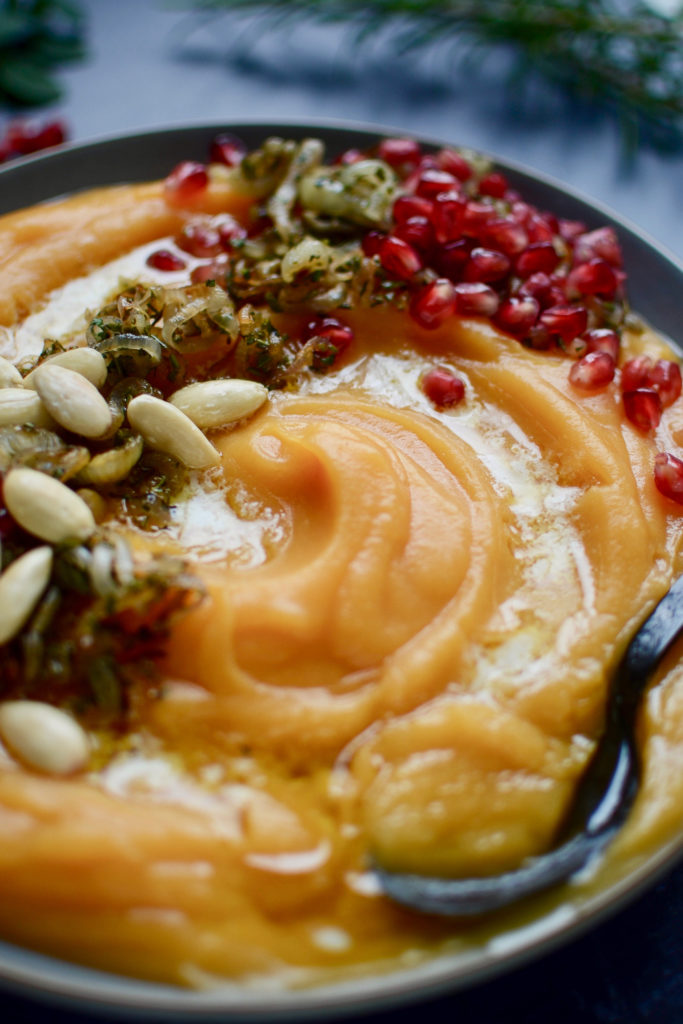
Swede and sweet potato mash
Serves 4 – 6
Ingredients
1 swede, peeled and roughly chopped
2 large sweet potatoes, peeled and roughly chopped
glug of olive oil
1 tablespoon butter (or more olive oil to keep it vegan)
6 shallots, finely chopped
1 teaspoon very finely chopped rosemary
1 tablespoon finely chopped fresh oregano (or use 1 teaspoon dried)
salt and freshly ground pepper
To serve
pomegranate seeds
blanched almonds, lightly roasted
butter
Method
- Toss the swede and sweet potato with a little olive oil, salt and pepper, spread out on a baking sheet and roast in the oven at 180˚C for 40 mutes or until tender and lightly coloured. You will need to toss the pieces halfway through.
- While the veg are roasting, gently cook the chopped shallots and chopped rosemary in the butter until the shallots start to colour. Turn up the heat a little and caramelise for a further 5 to 10 minutes until nicely golden. Add the chopped oregano and set aside.
- When the vegetables are tender, place in a food processor and blitz until you have a lovely smooth consistency. Spread out on a plate, top with caramelised onions, pomegranate seeds, roasted almonds and more butter if required.
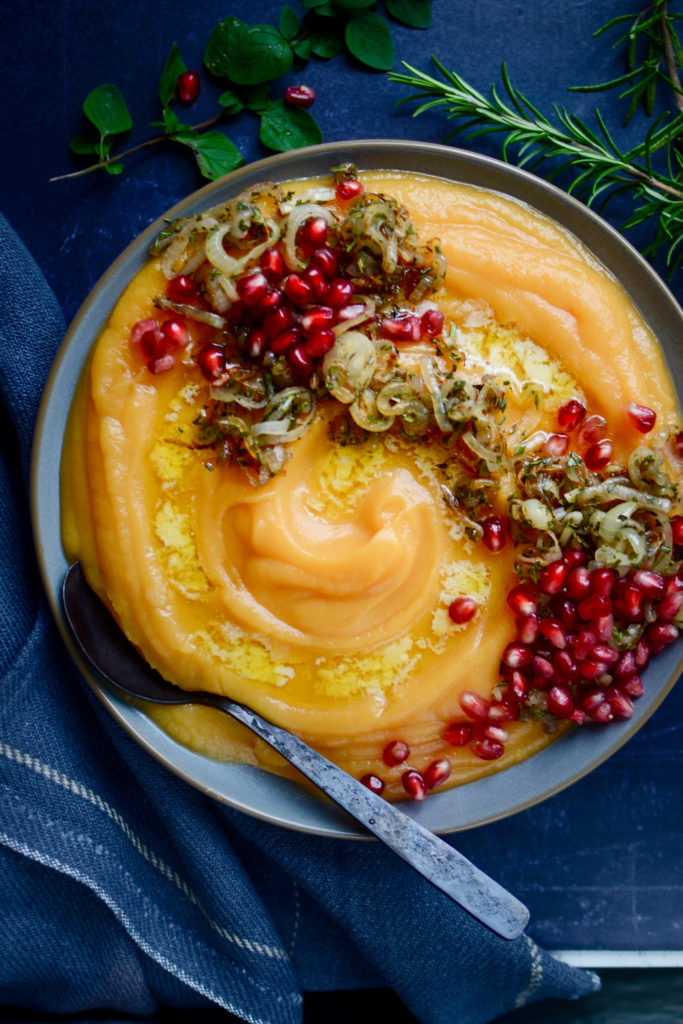
Chocolate bark with macadamia nuts, dried banana and sea salt
Another delicious topping for chocolate bark is a combination of toasted macadamia nuts, dried bananas and flaked sea salt. Drizzle everything with melted milk chocolate and ta-dah!
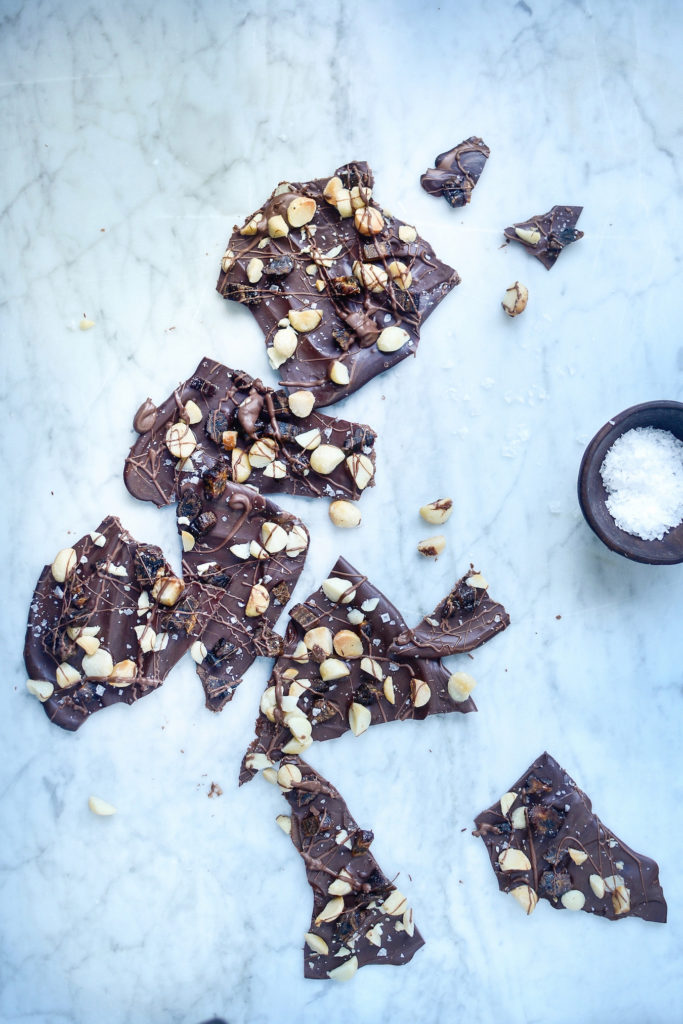
Chocolate bark with macadamia nuts, dried banana and sea salt
Makes enough for 2 – 4 little bags
Ingredients
150g dark chocolate (minimum 60% cocoa solids)
large pinch of sea salt flakes
30g (1/4 cup) macadamia nuts, toasted for 5 minutes at 180˚C pre-heated
30g dried bananas, finely chopped
5g popped quinoa, optional
20g milk chocolate
Method
- Melt 2/3 of the dark chocolate in a double boiler until just melted, stirring continuously. As soon as it has melted, stir in the rest of the chocolate until all has melted. You could also melt the chocolate in a microwave in 15 second bursts, stirring after each, until just melted. Do not let the chocolate get warm.
- Pour the melted chocolate onto a large piece of greaseproof paper and quickly spread out to about 1/4” thickness with a spatula.
- Quickly scatter over all the toppings evenly.
- While the bark is cooling, melt the milk chocolate in the same way as the dark chocolate. Either drizzle this over the bark with a spoon or use a small sandwich bag (or piping bag) to pipe the melted chocolate onto the bark. Set aside to cool completely.
- Peel away the paper and snap into pieces.
Cashew butter truffles
After a rather busy year (yes, sorry, I know…) the last thing you need is someone suggesting you actually MAKE your Christmas presents from scratch. Except… taking the time to create a gift for someone you love (like these cashew butter truffles or perhaps matcha and cacao pinwheels) is wonderfully festive, therapeutic, and probably also a lot more meaningful than anything store-bought.
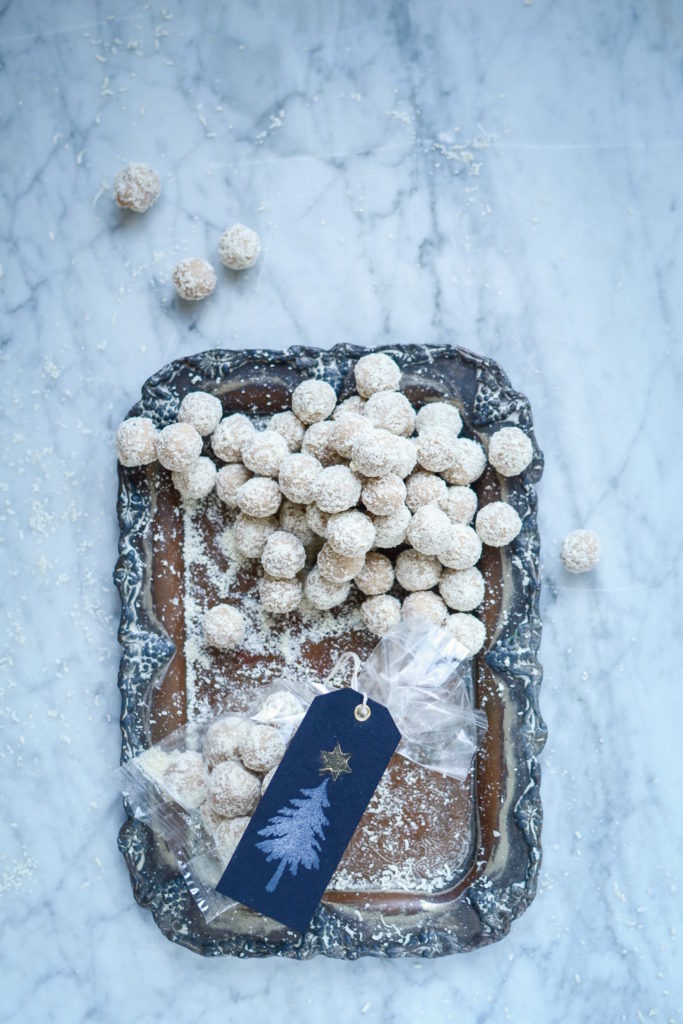
I encourage my children to make their own cards and find ways to bring joy without spending a penny in a shop and they love the challenge of coming up with the perfect gift. They also love making chocolate truffles with me – ha! These are so easy – cashew butter, melted cacao butter, honey and salt – and keep very well for several weeks.
Cacao Butter is the edible fat extracted from the raw cacao bean. It looks like white chocolate in solid form (at room temperature or colder) and turns into a beautiful amber liquid when heated. The higher the cacao butter content in a chocolate, the more luxurious and smooth it will be. You can buy it from most leading supermarkets and specialist confectioners these days. If you want to keep the truffles vegan, use maple syrup instead of honey, and be sure to use a vegan white chocolate or pure cacao powder for coating.
Cashew butter truffles
Makes 80 very small truffles
Ingredients
110g (1/2 cup) raw cacao butter
75g (1/4 cup) raw honey or maple syrup
80g (1/4 cup plus one heaped tablespoon) crunchy cashew nut butter
1/4 teaspoon fine grain rock salt
30g good quality white chocolate, grated for coating
Method
- Melt the cacao butter in a small saucepan over a gentle heat.
- Whisk the melted fat, honey, cashew nut butter and sea salt until well mixed.
- Set aside to firm up at cool room temperature for a few hours, or in the fridge for an hour or so.
- Roll half teaspoons full between your palms until round, then roll in the grated white chocolate. Repeat until you’ve used up all your mixture.
- If you do refrigerate it, it will have to stand at room temperature for a while, before you are able to roll it.
Note: If you can’t find crunchy cashew butter, use smooth and add a handful of chopped roasted cashew nuts.
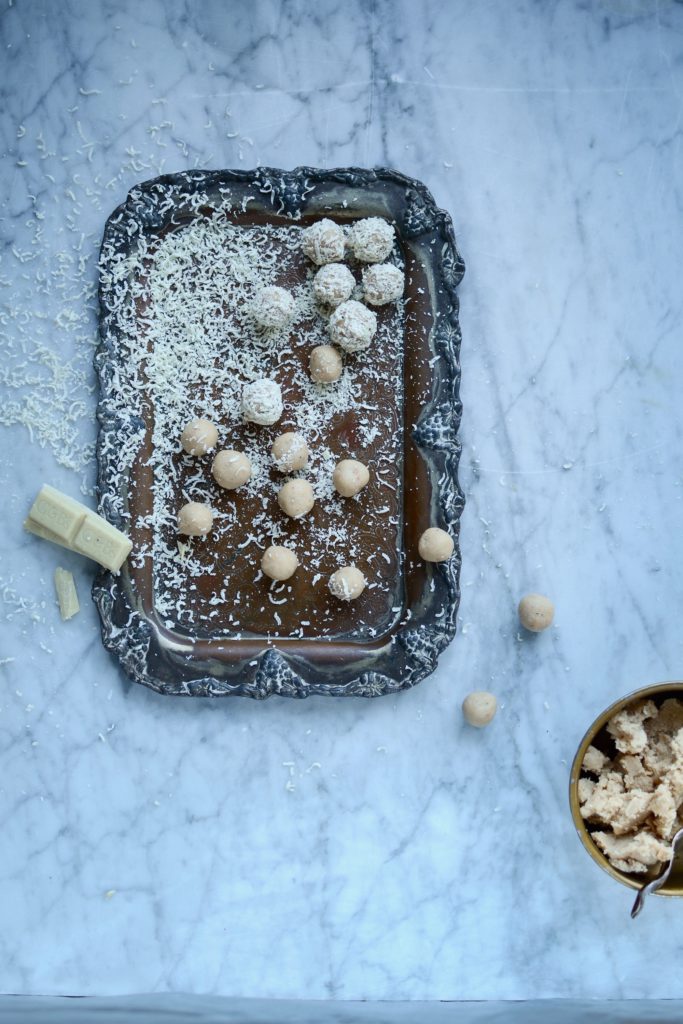
Cranberry and pomegranate ice cream cake
Hands up if you like the sound of “hassle-free entertaining”? Yeah, me too. Especially when you know there will be a lot of other things to worry about like last-minute gift wrapping, keeping an eye on the goose stuffed into your tiny oven or going into labour with your third child… This ice cream cake is the ideal make-ahead dessert and with its tart, refreshing coolness, will round off a heavy Christmas meal perfectly.
Cranberry and pomegranate ice cream cake
Makes one deep 6” or 15cm cake (3” or about 8cm high) and serves 8 – 10
Ingredients for the cranberry compote
400g cranberries
165ml (2/3 cups) fresh pomegranate juice
65g (less than 1/2 cup loosely packed cup) unrefined dark brown moist sugar or coconut palm sugar
1 vanilla pod, split in half lengthwise
To assemble
1.25 litres vanilla ice cream of your choice (vegan or coconut is fine too)
desiccated coconut
To serve
fresh pomegranate seeds
Method
- Place the ingredients for the compote in a heavy-based saucepan over a low heat and stir to dissolve the sugar, before turning up the heat and simmering gently for about 5 minutes, or until the cranberries are tender. Allow to cool slightly before blending everything until smooth. If you don’t have a high-speed blender, remove the vanilla pod, scrape out the seeds and return these to the cranberry mix. Discard the pod.
- Set aside to cool completely, preferably in the fridge.
- To start assembling the cake, allow 500ml of the ice cream to soften at room temperature.
- Mix 250ml (1 cup) of the cranberry puree with 450ml of the ice cream until well blended, spoon into a 15cm cake tin, smooth the top and place in the freezer for at least 10 – 15 minutes or until frozen. In the meantime, replace the left-over ice cream in the freezer and leave the next 500ml of ice cream at room temperature to soften.
- For the second layer, mix 125ml (1/2 cup) of the cranberry puree with 500ml ice cream until well blended. Spoon on top of the first layer, smooth the top and place in the freezer for 10 – 15 minutes.
- Finally, use as much of the remaining softened plain vanilla ice cream as is necessary to fill the tin to the top and return to the freezer. Leave for several hours or until solidly frozen.
- About 15 minutes before serving, remove from the freezer and allow to soften.
- Carefully remove the tin (you may want to run some hot water around the tin or use a blow torch if it is still solidly frozen) and place the cake on your serving plate with the vanilla layer on top. Sprinkle the coconut around the base and on top to create a snowy landscape. Bring the cake to the table and wait until it is soft enough to cut into slices, before serving with fresh pomegranate seeds.
An Easter cake fit for a king
Easter is a special time of celebration in our household and even though we (well, I!) try to limit chocolate consumption to a manageable amount, a showstopper cake seems to fit the occasion. This squash and parsnip cake relies on olive oil for its moist and dense texture, whilst the flavour is a delightful mix between earthy and fresh, and not at all too sweet. All you need now is a freshly brewed cup of tea and a comfy seat.
Butternut squash and parsnip cake with saffron icing
Makes 1 small (18cm) double layered cake
Ingredients for the cake
170g wholemeal spelt flour or gluten-free flour
130g chickpea / garbanzo bean / gram flour
1 tablespoon baking powder
pinch of sea salt
200g coconut blossom sugar or light muscovado sugar (lumps removed to avoid holes in your cake)
seeds of 12 – 15 green cardamom pods, ground with mortar and pestle
185ml (3/4 cup) extra virgin olive oil
4 eggs, preferably organic and pastured
30ml (2 tablespoons) milk of your choice if you are using gluten-free flour
Zest of 2 oranges, preferably unwaxed and organic as citrus fruit is often heavily sprayed with pesticides
150g peeled and grated butternut squash
150g peeled and grated parsnips
Ingredients for the frosting
large pinch of saffron, ground into powder with mortar and pestle
50g butter (preferably organic and grass-fed), softened
250g full-fat organic cream cheese (preferably organic and grass-fed), at room temperature
30ml (2 tablespoons) honey, preferably raw
pinch of sea salt
Method
For the cake:
- Preheat the oven to 160°C/320°F. Grease and line two 18cm round cake tins with parchment paper.
- In a large bowl, whisk together the flours, baking powder, salt, sugar and cardamom powder.
- Separately, whisk the olive oil, eggs and orange zest until combined.
- Make a well in the centre of the flour mix, and pour in the eggs. Stir to combine, then gently mix in the carrot and parsnip. If the grated strands are on the long side, run a sharp knife through the veggies a few times before adding to the batter (this will help prevent any bubbles or unevenly cooked bits).
- Divide the cake mix between the two tins, tap them vigorously on your counter top to allow air bubbles to escape and bake for about 55 minutes, or until golden and a skewer or toothpick inserted in the centre of the cake comes out clean. Cool the cakes in the tin for a few minutes, then remove from and allow to cool completely on a wire rack.
For the frosting:
- Soak the ground saffron in just enough hot water to cover for at least 20 minutes.
- Beat the butter until soft and light. Add the cream cheese and continue to beat until smooth.
- Add the honey and salt and beat another few seconds.
- Now you can either add all the saffron water or divide the frosting into thirds, colouring each third slightly more yellow than the one before. Use the three shades to create an ombre effect cake.
- Place the frosting in the fridge and allow to set to a pipe-able consistency before icing your completely cooled cake.
Green crêpes with cayenne cashew cream
We love pancakes in any shape and size. And it is one of the easiest way to serve vegetables to your family – either mixed straight into the batter or as a filling. These Tuscan kale crêpes, a.k.a. dragon slayer pancakes, are delicious with a savoury cashew cream, but you could also serve them with grated (preferably unpasteurised) cheddar cheese or goat milk feta. And I usually reserve some of the batter to make a few plain ones to have with honey and lemon as a special Pancake Day dessert.
Ingredients for the crêpe batter
5 medium eggs
240g (2 cups) wholemeal spelt flour
500ml (2 cups) water
large pinch of sea salt
200g Tuscan kale (also known as cavolo nero, dinosaur or lacinato kale), thick cores discarded, roughly chopped
Method
- Steam (or briefly blanch) the kale until wilted, then refresh under ice cold running water.
- Put all the ingredients in a blender and blend until well mixed.
- Set aside for at least 1 hour.
- To make the crêpes, heat a little ghee or coconut oil in crêpe pan until hot, but not smoking. Pour a ladleful of the batter into the pan, turning it while you pour to ensure you cover the base.
- As soon as the edges have browned (after a few minutes), carefully slide a spatula under the crêpe and flip it over for another couple of minutes. Repeat until all the batter has been used up.
Ingredients for the cashew cream
125g (about 1 cup) cashew nuts, soaked for 2 – 4 hours in fresh cold water
100 – 125ml (about 1/2 cup) water
large pinch of sea salt
1 teaspoon nutritional yeast flakes
generous squeeze of lemon
large pinch of cayenne pepper
Method
- Rinse the soaked cashews thoroughly, then place in a blender with just under half a cup of water (about 100ml), salt, nutritional yeast, lemon juice and cayenne, and blend until creamy.
- If you don’t have access to a high speed blender, the resultant cream will have a coarser texture.
- Adjust seasoning and spoon onto a green crêpe before rolling up.
Picnic à deux
Ok, full disclosure: I don’t really celebrate Valentine’s Day.
I used to, but that was before I married another Capricorn at the end of January. By the time Christmas, New Year’s Eve, our respective birthdays and our wedding anniversary have been duly celebrated, we are usually ready for a break.
I am a HUGE fan of romantic dates, however. Any time, any place. And if Valentine’s Day happens to be the next available opportunity to spoil your sweetheart, then make the most of it with this easy peasy, super sexy stay-at-home picnic for two. Open fires and games of scrabble optional.
The Ruby Noir
Makes 2 cocktails
Ingredients
60ml (1/4 cup) 100% pomegranate juice, chilled
30ml (2 tablespoons) damson, plum, blackberry or sloe vodka
1 teaspoon sweetened lime juice (squeeze out half a lime and stir in 1 teaspoon honey)
Champagne or sparkling wine, chilled
1 teaspoon pomegranate seeds
2 small and fine rosemary twigs (optional)
Method
- Mix the pomegranate juice, vodka and lime juice, then divide between two champagne flutes, pouring through a funnel if you want to keep it extra neat.
- Top up with Champagne, by carefully pouring the bubbly into the glass over the back of a metal spoon to “float” it on top of the pomegranate mix.
- Carefully float a few pomegranate seeds on top and finish with a rosemary twig, if you like.
Spiced rye crackers with figgy goat’s cheese
Ingredients for the crackers
Makes about 18 small crackers, but feel free to double or triple the recipe – they keep well
50g (1/3 cup) stoneground rye flour
pinch of salt
pinch each of caraway seed, aniseed and cumin
10g (about 2 teaspoons) cold butter, cut into small cubes
15ml (1 tablespoon) or thereabouts milk of your choice (I used almond milk)
Ingredients for the figgy goat cheese
Enough for 2 people
70g (1/3 cup) soft goat cheese
1 large soft dried fig, finely chopped
1 teaspoon finely chopped parsley, leaves only
sea salt and freshly ground black pepper
aged Balsamic vinegar to serve (optional)
Method
- For the crackers: preheat the oven to 220°C / 420°F. Line a small baking sheet with parchment paper.
- Whisk together the flour, spices and salt. Using your finger tips, rub the butter into the flour until it resembles fine bread crumbs.
- Add the milk and knead the dough until it comes together in a soft ball – not too sticky, and not crumbly.
- Roll the dough out thinly and use a cookie cutter to cut out shapes. Place these on the prepared sheet.
- Bake for roughly 10 minutes, or until the edges have turned golden, then remove from the oven and allow to cool on a cooling rack.
- For the goat cheese: while the crackers are baking, mix all the ingredients for the cheese in a bowl, adjust seasoning and set aside.
Scallop pops with avocado aïoli
What can be more seductive than nibbling on a sizzling scallop lollipop? These guys are the perfect mess-free picnic food and add just the right amount of spice to wake up the senses. Serve with a plate of gorgeous roasted mixed beets.
Ingredients for the marinade
handful of fresh coriander (cilantro), finely chopped
1 small red chilli, finely chopped (deseeded and membranes removed if you prefer it milder)
1 large garlic clove, thinly sliced
splash of olive oil
For the pops
6 large or 8 small scallops
knob of butter, preferably organic
4 to 6 wooden skewers
Ingredients for the avocado aïoli
1 small ripe avocado, mashed
1 – 2 tablespoons garlic aïoli or mayonnaise, preferably home-made
squeeze of lemon
sea salt
Method
- Mix all the ingredients for the marinade and rub it into the scallops. Set aside for at least half an hour.
- While the scallops are marinating, mix together the ingredients for the avocado aïoli and refrigerate.
- When you are ready to fry the scallops, pick out the garlic slices, as they burn too easily, and heat the butter in a heavy bottomed skillet or pan over a medium heat.
- Fry the scallops for a minute or two on each side – do not overcook them! – then slide one to two onto each skewer. Season with sea salt and serve with the avocado aïoli.
Chocolate-drizzled pear and raspberry lollies
For me, a romantic dinner has to be delicious, yes, but definitely not too filling. Who wants to feel stuffed and uncomfortable on a date? These refreshing, yet luscious lollies will hit the spot.
Makes 4 small or 2 large lollies
Ingredients for the lollies
teaspoon of coconut oil
2 pears, peeled, cored and quartered
1 teaspoon molasses sugar or dark brown muscovado sugar
80g (1/2 cup) frozen or fresh raspberries, plus a few extra
60ml (1/4 cup) milk of your choice (I used almond milk)
Ingredients for the chocolate drizzle
10g / 10ml (2 teaspoons) coconut oil
20g (about 6 squares) dark chocolate, broken into small pieces
Method
- For the lollies: heat the coconut oil in a heavy based saucepan until hot, then lay the pear quarters down, sprinkle over the sugar and do not turn until they’ve developed a lovely golden colour and the sugar has melted (about 5 to 10 minutes).
- Turn over and fry on the other side for another 5 minutes.
- Now blend the pears, raspberries and milk until smooth. Stir in the remaining raspberries (crush them if they are frozen) and fill the ice lolly moulds.
- Freeze for at least 4 to 5 hours.
- For the chocolate drizzle: put them coconut oil in a small saucepan and heat over a low heat until melted.
- Add the bits of chocolate and continue to warm over a medium heat until melted.
- Give it a quick whisk, then set aside to cool slightly.
- Run hot water over the moulds to remove the lollies. Using a spoon, drizzle some chocolate sauce over each and give it half a minute or so to set.
Three cabbage slaw and a Christmas wish
I do have a Christmas wish that does not involve world peace, well-behaved children or the Myla Arietta playsuit. It is to sit down at a beautiful, heavily laden Christmas table that I did not have to lift a finger to prepare. Ahhhh. Usually this is THE time of year for me. I love cooking festive dishes and I absolutely love planning for it. But I have had a pretty busy 12 months and Chopper, my trusty chef’s knife, needs a break. But before that happens, here is a sassy little recipe for you. It might even make it on to your Christmas menu…
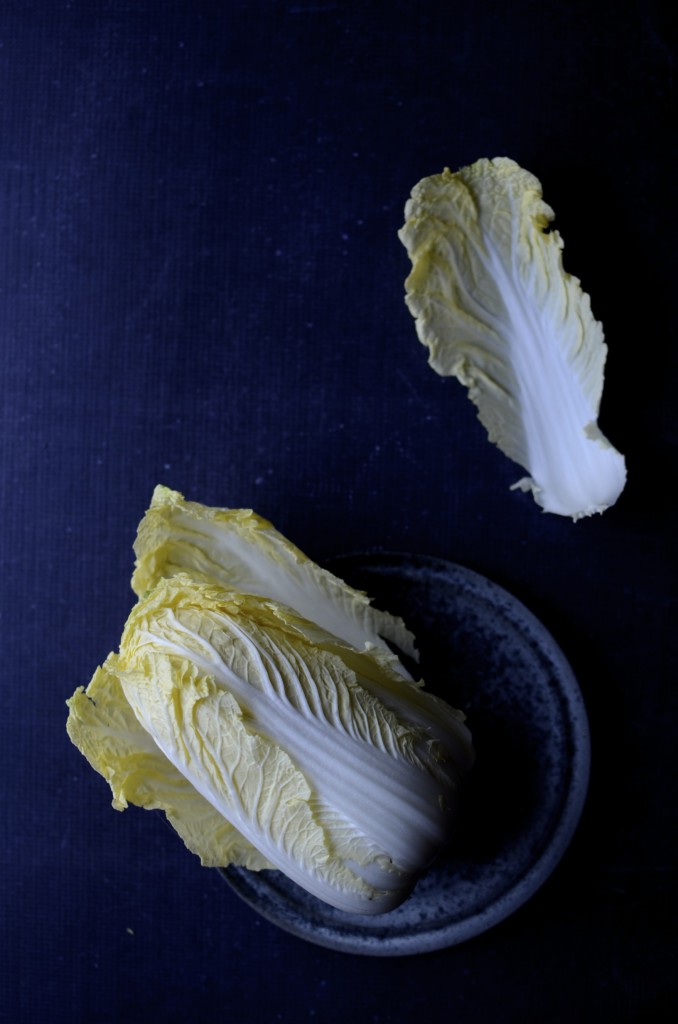 Health-supportive cabbages can be harvested throughout the year and there are many different varieties. They are delicious raw, stir-fried, braised, steamed, grilled and wrapped around different morsels. Short cooked or raw cabbage, especially Savoy cabbage, is a very good source of sinigrin, a glucosinolates (a natural component of many pungent plants such as mustard, cabbage and horseradish) that can be converted into allyl-isothiocyanate (or AITC), a colourless oil that is responsible for the pungent taste of plants such as radishes and which has shown unique cancer preventive properties with respect to bladder cancer, colon cancer, and prostate cancer. Don’t let that be the only reason to have this salad, though. It is quick and easy to prepare and adds a hit of freshness to any meal.
Health-supportive cabbages can be harvested throughout the year and there are many different varieties. They are delicious raw, stir-fried, braised, steamed, grilled and wrapped around different morsels. Short cooked or raw cabbage, especially Savoy cabbage, is a very good source of sinigrin, a glucosinolates (a natural component of many pungent plants such as mustard, cabbage and horseradish) that can be converted into allyl-isothiocyanate (or AITC), a colourless oil that is responsible for the pungent taste of plants such as radishes and which has shown unique cancer preventive properties with respect to bladder cancer, colon cancer, and prostate cancer. Don’t let that be the only reason to have this salad, though. It is quick and easy to prepare and adds a hit of freshness to any meal.
Three cabbage slaw
Serves 2
Ingredients for the dressing
1 tablespoon mayonnaise, preferably home-made
1 tablespoon grapefruit juice (reserved after segmenting the grapefruit)
1 teaspoon Dijon mustard
sea salt
1 tablespoon minced chives
1 tablespoon extra virgin olive oil
maple syrup to taste
Ingredients for the slaw
1 handful finely shredded red cabbage
1 handful finely shredded Savoy cabbage
1 handful finely shredded Chinese or Napa cabbage
1 grapefruit, segmented with a sharp knife
1 chilli, finely chopped (remove seeds and membranes if you prefer it milder)
Method
- Scoop the mayonnaise into a small bowl and add the rest of the ingredients while stirring.
- Adjust seasoning.
- Toss all the salad ingredients together and dress just before serving.
If you have started thinking about your Christmas menu, allow me to suggest a few things:
- make to do lists and even consider marking important “deadlines” in your calendar – it sounds a little OCD, but it avoids last-minute dashes to the store and ensures your best chances of serving truly festive fowl
- choose as many dishes as possible that can be partly or wholly prepared ahead and remember that not EVERYthing has to be home-made
- on the night, set up a bar for guests to mix their own cocktails and be sure to serve yourself too
- have a plan ready for the leftovers and hand it over to the rest of the family on Boxing Day while you put up your feet for a well-deserved break
A punch for the piccoli
The Christmas cheer usually overwhelms me right around the beginning of December. We get out the cherished decorations, adorn the front door with a wreath, and start building the anticipation with advent candles and calendars. For me, Glühwein (mulled wine) or Rumpunsch (rum punch) are as much a part of the festive season as Lebkuchen (gingerbread) and St Nicholas Day on the 6th of the month. Feeling somewhat cheated, my son asked me last year to make a special Christmas punch for the little ones. This recipe makes four cups and will keep the youngsters happy. At least for another few years…
Ingredients
750ml (3 cups) boiling water
3 teabags of fruit tea or, to stave off winter colds, berry and echinacea tea
1 cinnamon stick
1 star anise
5 cloves
strips of orange peel
250ml (1 cup) freshly squeezed orange juice (about 3 – 5 oranges, depending on their size and juiciness)
Method
- Put all the ingredients, apart from the orange juice, in a small pot and simmer for at least 30 minutes.
- Either strain the tea or scoop all the bits out with a slotted spoon.
- Divide the orange juice equally between four cups and top up with hot spiced tea.
Four persimmons and a pumpkin pie
The autumn colours, sights and sounds stir a certain longing in most cooks to bake. For many North Americans this means pumpkin pie – a dish almost synonymous with the autumnal Thanksgiving celebrations. In South Africa, we grew up eating pumpkin fritters doused with cinnamon sugar alongside our Sunday roast, so a sweet dish with pumpkin as its star is no stranger to me. In my pie recipe, however, the pumpkin (or butternut squash) shares centre stage with some gorgeous persimmons.
Persimmons vary in colour from golden yellow to burnt orange and red, and can be round or oval. Persimmon trees carry either astringent fruit (whilst unripe) or non-astringent fruits. The astringent cultivars (such as Eureka, Hachiya, Saijo, Tamopan, Tanenashi, Triumph, etc.), are high in tannins and must be allowed to ripen fully until the flesh attains a consistency akin to jelly. The non-astringent kinds (Fuyu, Gosho/Giant Fuyu/O’Gosho, Imoto, Izu, Jiro, Maekawajiro, Okugosho, Suruga, etc.) contain less tannins and can be eaten when still crispy.
Persimmon fruit, originally from East Asia, has a sweet, succulent flesh that holds several health promoting benefits. Persimmons contain flavonoid poly-phenolic anti-oxidants such as catechins and gallocatechins in addition to an important anti-tumour compound, betulinic acid. Catechins are known to have anti-infective, anti-inflammatory and anti-hemorrhagic properties. Fresh persimmons also contain other anti-oxidant compounds like vitamin A, vitamin B, vitamin C, beta-carotene, lycopene, lutein, zea-xanthin and cryptoxanthin. Together, these compounds functions as protective scavengers against oxygen-derived free radicals and reactive oxygen species that play a role in ageing and various disease processes. Fresh persimmons also contain minerals like potassium, manganese, copper, and phosphorus.
Pumpkin and persimmon pie
Makes one 28cm pie
Ingredients for crust
115g (about 1 cup) wholemeal spelt flour
60g (about ½ cup) stoneground rye flour
25g (2 tablespoons) date sugar or unrefined brown sugar
large pinch of sea salt
110g cold butter, cut into pea-sized pieces
15 – 30ml (1 – 2 tablespoons) ice cold water
Ingredients for filling
850g peeled and cubed butternut squash (about 1 medium butternut), roasted (should yield 360g or 1 ½ cups mashed roasted flesh)
flesh of 4 ripe persimmons (cut in half horizontally and scoop out with a spoon)
100g (about ½ cup) date sugar or unrefined brown sugar
60g (1/3 cup) unrefined brown sugar
2 teaspoons ground cinnamon
1 heaping teaspoon ground ginger
generous grating of nutmeg (about 1/2 a nut)
¼ teaspoon allspice
pinch of salt
125ml (½ cup) milk of your choice
125ml (½ cup) organic double (heavy) cream
3 large eggs
Method
- Grease a 28cm (or 11 inch) loose-bottomed tart form.
- For the pastry: put the flours, date sugar, salt and cold butter in the bowl of a food processor and blitz until it looks like coarse sand. This step can also be done by hand by rubbing the butter into the flour with your finger tips.
- With the motor running, add 1 to 2 tablespoons ice cold water or until the dough starts coming together. Or if you are doing it by hand, just keep sprinkling cold water on the dough until it starts to come together.
- Tip the pastry out into a bowl and knead very briefly until you have a smooth (not crumbly or sticky) ball of dough.
- Roll out thinly between two pieces of greaseproof paper, then fold it over your rolling pin and lay it across your greased tart form. Press the pastry into the edges and up along the sides, trimming where necessary. Refrigerate for at least half an hour.
- Preheat oven to 180°C / 360°F.
- When the pastry is completely firm, remove from fridge and place on a baking sheet. Partially blind bake in the hot oven for 10 minutes.
- To make the filling: in a food processor, puree the roasted squash, persimmon flesh, date and brown sugars, and spices until very smooth. Scrape the filling into a little pot and, stirring continuously, cook over medium heat until the mixture starts to bubble (about 5 – 7 minutes). Set aside.
- Whisk together the milk, cream and eggs, then whisk the pumpkin mixture into the egg mixture.
- Carefully pour the filling into the pastry shell and bake for 30 minutes or until filling is lightly cracked around edges and still a tiny bit wobbly in the centre. Allow to cool completely before slicing.
- Serve with Greek yoghurt, soured cream or crème fraîche.

